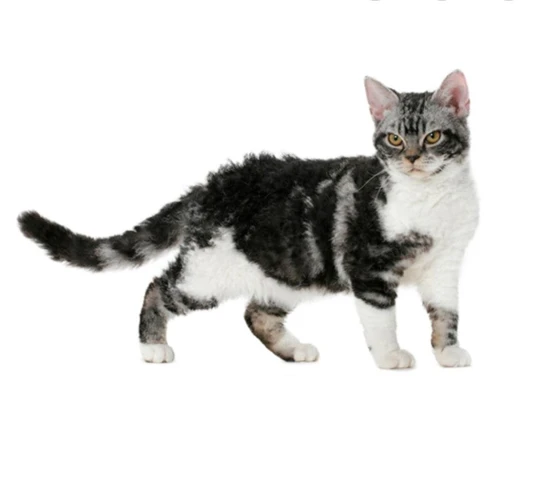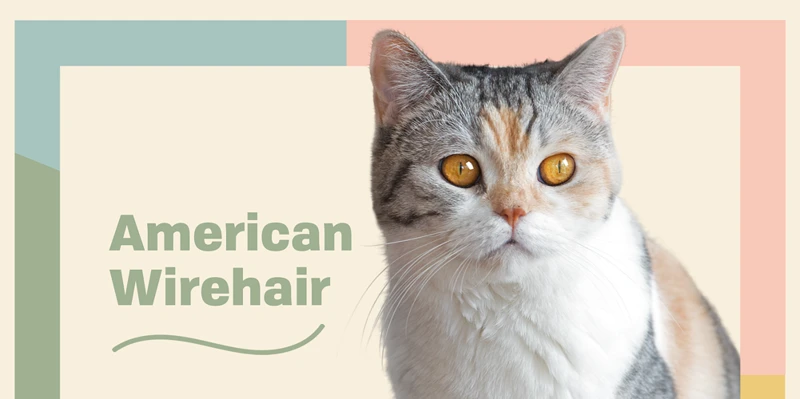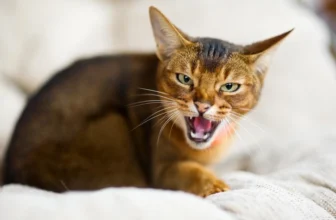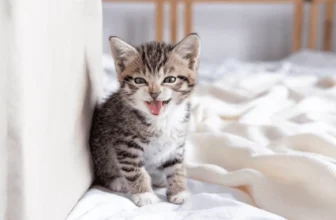Introduction

It’s no secret that cats have a reputation for being independent and aloof creatures, but American Wirehair cats are quite the opposite. These feline beauties are known for their friendly and outgoing personalities, making them great companions for households with children and other pets. However, like any animal, American Wirehair cats may exhibit aggressive behavior from time to time. This can be concerning and even dangerous if left unaddressed. In this article, we’ll explore the possible causes of aggressive behavior in American Wirehair cats, as well as effective training techniques and preventive measures that can help correct this behavior and ensure a happy and harmonious home life.
About American Wirehair Cats
American Wirehair cats are a unique breed known for their distinctive coarse and curly hair. These cats originated in the United States and were first discovered in upstate New York in the 1960s. The American Wirehair breed was a result of a spontaneous mutation in a litter of barn cats. They are medium-sized cats with strong, muscular bodies and round faces.
Personality: American Wirehair cats are known to be affectionate and friendly towards their owners. They are playful and energetic, with a love for climbing and exploring their environment. However, like all cats, they can show signs of aggression if not trained and socialized correctly.
Physical Characteristics: In addition to their curly hair, American Wirehair cats have broad heads, rounded ears, and large, expressive eyes. They come in a variety of colors, including tabby, solid colors, and bi-color. These cats have a unique coat that is springy to the touch and resistant to water.
Health: American Wirehair cats are generally healthy and have no specific health concerns that are exclusive to their breed. However, like all cats, American Wirehairs should have regular veterinary check-ups to ensure they are healthy and up-to-date on their vaccinations.
Diet: To maintain the cat’s good health, a balanced diet is crucial. American Wirehairs should be fed a diet consisting of high-quality protein and nutrients. It’s important to avoid overfeeding your cat, as obesity can lead to other health problems.
Exercise: American Wirehair cats are active and need plenty of playtime and exercise. Engaging in playtime with toys, puzzles, and hide-and-seek games can help reduce their aggression levels.
American Wirehair cats are a wonderful breed that can make great companions if trained and socialized correctly. With proper care and attention, these cats can be a loyal and affectionate member of your family. If you’re interested in learning more about the aggression in American Wirehair cats, you can click here to read more.
Causes of Aggressive Behavior

Understanding the reasons behind aggressive behavior in American Wirehair Cats is essential in preventing and addressing the issue. Several potential causes can contribute to aggression in felines. In this section, we will explore these causes in detail to identify common triggers and possible ways to mitigate them. By understanding the underlying factors that lead to aggressive behaviour, you can proactively prevent and address poor behaviour, and foster a healthy and happy environment for your pet.
Health Issues
It’s important to note that health issues can be a major contributor to aggressive behavior in American Wirehair cats. This aggression can be a result of chronic pain, an injury, or even an undiagnosed illness. If a normally friendly and affectionate cat suddenly exhibits aggressive behavior, it’s essential to consult with a veterinarian before trying to address the behavioral issues.
Some common health issues that can cause aggressive behavior include feline hyperesthesia syndrome (FHS), dental problems, and thyroid issues. FHS is a condition that affects the cat’s nervous system and can cause them to become overly sensitive to touch. Dental problems can also cause discomfort, leading to aggression towards people or other cats who get too close to the affected area.
If a medical condition is causing the behavior, addressing the underlying issue should be the first step. However, even once the medical issue is resolved, it may take some time for the cat to unlearn the aggressive behavior. In such situations, it is recommended that pet owners work on their cat’s behavior in conjunction with the treatment of any medical conditions.
It’s crucial to understand that medical issues can be difficult to diagnose, and mistaking behavioral problems for a health issue can lead to a delay in proper treatment. If pet owners are unsure, it’s essential to consult with a veterinarian before starting any behavior modification techniques.
Properly addressing any medical issues can alleviate much of the discomfort that may be causing the behavior. Nonetheless, if your American Wirehair cat’s aggression persists even after a health issue is addressed, it’s crucial to seek advice on implementing training and preventive measures for dealing with aggressive behavior in cats.
Tip: Check out our article on preventing aggression in American Wirehair Cats in multicat homes for more information on preventing aggression in felines.
Territorial Instincts
Territorial instincts are natural behaviors displayed by many animals, including cats. American Wirehair cats may become more aggressive when they feel that they need to protect their territory. Such behavior can be triggered when another cat or animal enters their space.
Signs of territorial aggression
One of the signs of territorial aggression in American Wirehair cats is their desire to claim a certain space as their own. They may mark this territory by leaving behind urine or feces, scratch marks on furniture or other objects, or by rubbing their scent glands against surfaces.
Another sign of territorial aggression is growling, hissing, or yowling when other cats or people come near their space. They may also display aggressive body language, such as an arched back, puffed-up fur, and flattened ears.
How to deal with territorial aggression
To correct territorial aggression in American Wirehair cats, you must try to make them feel more secure in their environment. This can be done by providing them with a separate space that they can claim as their own. A special bed or scratching post can help them feel more comfortable in their surroundings.
You can also try to remove any triggers that may be causing your cat to feel territorial. For instance, if other cats or animals are making your cat feel threatened, make sure to keep them separated.
Providing plenty of playtime and exercise to your American Wirehair cat can help reduce territorial behavior. This can help them use up their excess energy and feel more relaxed in their environment.
Conclusion
Territorial aggression is a natural instinct for American Wirehair cats, but it can be corrected with proper training techniques and preventive measures. By understanding the signs of territorial aggression and addressing them through positive reinforcement and providing a secure environment, you can help your American Wirehair cat to exhibit healthy behavior.
Previous Trauma
One of the potential causes of aggressive behavior in American Wirehair cats is previous trauma. Trauma can come in many forms, including physical abuse, neglect, or even a lack of socialization during kittenhood. When a cat experiences a traumatic event, it can cause them to become fearful and anxious, which can manifest as aggression towards their owners or other pets in the household.
It’s important for pet owners to be aware of any past traumas their American Wirehair cat may have experienced, as this can provide insight into the source of their aggressive behavior. Some common signs of a traumatized cat include hiding, excessive grooming, and avoiding human interaction. If your cat has a history of trauma, it’s important to approach any training techniques with extra care and patience.
To help address aggression caused by past trauma, pet owners may want to consider enlisting the help of a professional animal behaviorist. These experts can work with cats to help them overcome their fears and anxieties through targeted training and behavior modification techniques. Additionally, engaging in activities that promote playtime and positive social interaction can also be beneficial for these cats.
It’s important to remember that cats are individuals, and each one will have their own unique set of triggers and behaviors. It’s essential to work closely with a professional to develop a customized plan for training and behavior modification. With patience, dedication, and the right approach, aggressive behavior caused by past trauma can be effectively addressed in American Wirehair cats.
Internal link: Aggression in American Wirehair Cats
Signs of Aggressive Behavior

It is crucial for cat owners to be able to identify the signs of aggressive behavior in their American Wirehair cats. This can help prevent any injuries and ensure a safe environment for both the cat and the owner.
One of the most obvious signs of aggression in cats is hissing, growling, and displaying aggressive body language such as ears flattened against the head or fur standing up. American Wirehair cats may also show their teeth, arch their backs, and lash their tails. They may even swat, scratch, or bite.
Another sign of aggression in American Wirehair cats is their excessive need to scratch things. When they start scratching excessively, especially in areas where they usually don’t, such as furniture or walls, it could be a sign of stress or territorial aggression. It is essential to address this issue right away before the cat causes excessive harm.
In some cases, American Wirehair cats may show aggression through fear. Fear aggression occurs when the cat feels threatened by unfamiliar surroundings, other animals, or people. Some signs of fear aggression include hiding away, hissing, growling, and biting.
Playing with your American Wirehair cat is an excellent way to bond with them and allow them to expend energy healthily. However, excessive or aggressive playtime that involves biting, scratching, or pouncing on their owner’s hands or feet can be a sign of reduced impulse control, leading to aggression issues.
It is necessary to monitor the behavior of your American Wirehair cat and understand the triggers that lead to their aggression. In many cases, preventing aggression in American Wirehair cats involves taking measures to avoid situations that may cause cats to feel stressed or react with fearful or territorial aggression.
By watching for the signs of aggression in American Wirehair cats, cat owners can take specific steps to reduce the risk of injury and provide a safe and comfortable environment for their pets.
Training Techniques

As an owner of an American Wirehair cat, it can be concerning to witness aggressive behavior from your feline friend. However, there are various training techniques that you can implement to address and correct this behavior. By using positive reinforcement, redirection of attention, clicker training, and desensitization, you can train your cat to react differently in trigger situations. These techniques can be especially effective in addressing aggression caused by health issues, territorial instincts, or previous trauma. Let’s explore some helpful training techniques to correct aggressive behavior in American Wirehair cats.
Positive Reinforcement
Positive reinforcement is one of the most effective training techniques for correcting aggressive behavior in American Wirehair cats. The process involves rewarding good behavior to encourage its repetition. This method is preferred over punishment since it focuses on promoting desired behavior rather than punishing unwanted behavior.
Here are some positive reinforcement techniques to correct aggressive behavior in American Wirehair cats:
- When rewarding with treats, ensure they are low calorie and given in small amounts to prevent excessive weight gain.
- Offer verbal praise and attention immediately after the desired behavior.
- Use toys or playtime as positive reinforcement when the cat shows good behavior.
It is crucial to be consistent with positive reinforcement. Repeat the reward every time the cat displays the desired behavior to strengthen the association between good behavior and positive feedback. This technique requires patience, but it is a highly effective and humane way to train American Wirehair cats.
If you want to learn more about aggressive behavior in American Wirehair cats, please visit our article on aggression in American Wirehair cats, territorial aggression, or fear aggression for more information.
Redirecting Attention
Redirecting attention is a technique that can be highly effective in correcting aggressive behavior in American Wirehair Cats. This approach involves shifting the cat’s focus away from the source of aggression to something more positive or less threatening. Here are some ways to redirect your cat’s focus:
- Toys: Offering your cat a toy, such as a stuffed ball or feather wand, can distract them from aggressive behavior and provide a fun outlet for their energy.
- Treats: Treats are another great way to redirect your cat’s attention. Offering a small piece of their favourite treat can help create a positive association with good behaviour.
- Scratching posts: American Wirehair Cats love to scratch, and redirecting their claws to a scratching post can be an effective way to redirect attention. Make sure the scratching post is sturdy and made from materials your cat will enjoy scratching on, such as sisal or carpet.
- Playtime: Regular playtime with your cat can help prevent aggressive behavior by providing an outlet for their energy. Try to set aside time each day to play with your cat.
It’s important to note that redirecting attention should not be used as the sole technique for correcting aggressive behavior. It should be combined with other training techniques such as positive reinforcement and desensitization. With consistent practice and patience, redirecting attention can help your American Wirehair Cat learn to redirect their aggressive tendencies towards more positive behaviour.
Clicker Training
Clicker training is a popular technique for correcting aggressive behavior in American Wirehair cats. This training method relies on using a clicker, which is a small device that makes a distinct “clicking” sound when pressed. The sound of the clicker serves as a signal to the cat that they have performed a desired behavior and will be rewarded. This technique is based on the principles of operant conditioning, which involves reinforcing desired behaviors.
The steps for clicker training your American Wirehair cat are:
- Step 1: Introduce the clicker – Start by introducing the clicker to your cat. Press the clicker and immediately give your cat a treat. Do this several times so your cat learns to associate the sound of the clicker with something positive.
- Step 2: Identify a behavior – Identify a behavior you want to reinforce. This could be something as simple as sitting still or coming when called.
- Step 3: Click and reward – When your cat performs the desired behavior, press the clicker and immediately reward your cat with a treat. This reinforces the behavior and teaches your cat that performing the behavior leads to a positive outcome.
- Step 4: Repeat and extend – Repeat the click and reward process several times, gradually extending the time between the behavior and the clicker. This teaches your cat that the behavior itself is what leads to the reward, not just the sound of the clicker.
- Step 5: Add verbal cues – Once your cat has mastered the behavior, you can add a verbal cue, such as “sit” or “come.” This associates the behavior with the verbal command, making it easier to ask for in the future.
Benefits of clicker training for aggressive behavior:
Clicker training is a safe and effective way to correct aggressive behavior in American Wirehair cats. It helps to reinforce positive behaviors and encourages your cat to repeat them. It is a humane training method that does not involve physical punishment or negative reinforcement.
Important tips for clicker training:
- Always use positive reinforcement – Only reward your cat for desired behaviors and ignore unwanted behaviors. Punishment can lead to fear and aggression.
- Be consistent – Use the same clicker sound and treat every time you train your cat. This helps to establish a routine and reinforces the behavior.
- Use high-value treats – Use treats that your cat loves, such as small pieces of cooked chicken or tuna. This makes the training more fun and rewarding.
Clicker training is an effective way to correct aggressive behavior in American Wirehair cats. It is based on positive reinforcement and encourages your cat to repeat desired behaviors. With consistency and patience, clicker training can be a valuable tool for helping your cat overcome their aggressive tendencies.
Desensitization
Desensitization is an effective training technique for correcting aggressive behavior in American Wirehair cats. It involves gradually exposing the cat to the trigger that causes the aggressive behavior, while providing positive reinforcement and rewards for calm behavior.
Here are the steps for desensitization training:
1. Identify the Trigger: The first step is to identify what triggers the aggressive behavior in your cat. This could be something as simple as a certain noise or a specific person.
2. Create a Plan: Once you have identified the trigger, create a plan to gradually expose your cat to it. This should be done in small increments, starting with a low-intensity version of the trigger and gradually increasing the intensity over time.
3. Reward Calm Behavior: During each exposure, reward your cat for calm behavior. This could be in the form of treats, affection or playtime.
4. Repeat: Repeat the exposure and reward process until your cat is desensitized to the trigger and no longer exhibits aggressive behavior.
5. Be Patient: Desensitization can take time, so be patient and don’t rush the process. It’s important to create a comfortable and safe environment for your cat during the training.
Desensitization is a humane and effective training technique that can help correct aggressive behavior in American Wirehair cats. This technique, along with other training methods such as positive reinforcement and redirecting attention, can help create a well-behaved and happy feline companion.
Preventive Measures

As the saying goes, prevention is better than cure. In the case of American Wirehair cats, it’s always better to establish a system of preventive measures to avoid aggressive behavior in the first place. By taking the necessary steps early on, you’ll be able to nip any potential problems in the bud and ensure that your furry friend remains happy and healthy. So, let’s take a closer look at some of the preventive measures you can take to avoid aggressive behavior in American Wirehair cats.
Early Socialization
The process of early socialization plays a crucial role in preventing aggressive behavior in American Wirehair cats. This involves exposing kittens to a variety of people, animals, and environmental stimuli in a positive and controlled manner. By doing so, kittens learn to be comfortable and confident in different situations, making them less likely to act out aggressively in the future.
To properly socialize your American Wirehair kitten, you can follow this simple table:
| Age | Activity | Objectives |
|---|---|---|
| 2-3 weeks | Handle the kittens gently for short periods of time every day. | To get them used to human touch and interaction. |
| 3-4 weeks | Introduce new sounds and smells in a controlled environment. | To stimulate their senses and desensitize them to potentially frightening stimuli. |
| 4-5 weeks | Gradually introduce a variety of objects including toys, scratching posts, and climbing structures. | To encourage playful behavior and develop their coordination and balance. |
| 5-7 weeks | Start introducing other pets in a supervised setting. | To teach kittens how to interact with other animals and establish social hierarchies. |
| 7-9 weeks | Gradually expose kittens to different people of different ages and genders. | To teach them how to interact with humans and recognize them as friendly. |
| 9-12 weeks | Encourage supervised exploration of the home environment. | To teach them the layout of their new environment and how to navigate it safely. |
It’s important to note that socialization should be done gradually and in a positive manner. Never force your kitten to interact with anything or anyone they clearly show discomfort or fear towards.
By properly socializing your American Wirehair kitten, you’re investing in their future behavior and emotional well-being. It’s an essential step in preventing aggressive behavior and creating a happy and confident feline companion in your home.
Proper Discipline
One of the crucial factors in preventing aggressive behavior in American Wirehair Cats is proper discipline. However, it is essential to note that discipline does not mean punishment. Punishments can create further stress in the cat and worsen the aggressive behavior. Instead, discipline refers to teaching the cat appropriate behavior and training them to follow positive actions. Here are some techniques for proper discipline:
| Technique | Description |
|---|---|
| Consistency | Cats are creatures of habit, and therefore, consistency is essential when it comes to disciplining them. Reinforce positive behaviors consistently through rewards and avoid negative behavior consistently by not giving in to their demands. |
| Never Use Physical Force | Physical punishment like hitting, slapping, or spanking can be detrimental to your cat’s well-being and worsen their aggressive behavior. Instead, opt for positive reinforcement training that rewards them for good behavior. |
| Use Verbal Cues | Cats thrive on positive affirmations from their owners. Use verbal cues like ‘good boy/girl’ or ‘well done’ when they follow your commands or display desirable behavior. |
| Provide an Alternative | If your cat displays aggressive behavior like clawing furniture, provide them with an alternative like a scratching post. Redirect their behavior to the new object by catching them in the act and moving them to the scratching post. With time, they will understand that scratching the furniture is inappropriate. |
Proper discipline is vital to prevent aggressive behavior and develop good behavior in American Wirehair Cats. Consistency, positive affirmations, avoiding physical force, and providing alternatives can help them thrive. Remember, cats are intelligent creatures that can learn and adapt to their environments with love, care, and positive reinforcement.
Providing a Safe and Comfortable Environment
American Wirehair cats, like any other pet, need a safe and comfortable living environment to prevent aggressive behavior. As a pet owner, there are a few things you can do to ensure that your cats feel safe and secure at all times. Here are some steps you can take to provide a safe and comfortable environment for your cat:
| Step | Description |
|---|---|
| 1. Provide a safe space | Create a designated area for your cat to retreat to when they feel overwhelmed or anxious. This space should be quiet, out of the way, and equipped with your cat’s favorite toys and comfy bedding. Be sure to provide plenty of hiding places if your cat is shy. |
| 2. Keep your home clutter-free | Cluttered and cramped living spaces can make your cat feel uncomfortable. Keep your home tidy and organized, and make sure your cat has plenty of room to play and explore. Provide plenty of scratching posts to help keep your cat’s claws in good condition. |
| 3. Create a predictable routine | Cats thrive on routine, and they feel most secure when they know what to expect. Set up a predictable routine that includes regular feeding times, playtime, and quiet time. This routine will help your cat feel more comfortable and less anxious. |
| 4. Provide plenty of mental stimulation | Cats need plenty of mental stimulation to prevent boredom and frustration. Provide your cat with plenty of toys, puzzles, and games that require problem-solving skills. Rotate your cat’s toys regularly to prevent boredom. |
| 5. Provide a variety of textures and surfaces | Cats love to scratch and climb, so be sure to provide plenty of safe surfaces for your cat to scratch and climb on. This will also help prevent destructive behavior. Providing a variety of textures will keep your cat interested and engaged. |
| 6. Maintain a clean environment | Cats are very clean animals, and they prefer a clean living environment. Be sure to clean your cat’s litter box regularly, and keep your home free of unpleasant odors. This will help your cat feel more comfortable and less stressed. |
By following these steps, you can help create a safe and comfortable environment for your American Wirehair cat, which can prevent aggressive behavior. Remember to always provide plenty of love and attention to your furry friend to keep them happy and content.
When to Seek Professional Help
It can be difficult to determine when aggressive behavior in American Wirehair cats warrants professional intervention. In some cases, training techniques and preventive measures may be successful in correcting the behavior. However, there are situations in which seeking the help of a professional is necessary.
Severe or Unpredictable Aggression: If your American Wirehair cat displays frequent or unpredictable aggressive behavior, it may be a sign of a deeper issue. Aggression that results in serious injury, whether to a person or another animal, is cause for immediate concern. Seeking the help of a professional behaviorist or veterinarian can help determine the underlying cause of the behavior and develop a plan to address it.
Aggression Due to Medical Issues: It’s important to keep in mind that aggressive behavior in American Wirehair cats can sometimes be a symptom of an underlying medical issue. Medical conditions such as hyperthyroidism, dental pain, or infections can cause cats to act aggressively. If there is no obvious trigger for your cat’s aggression, a visit to the veterinarian may be necessary to rule out any medical issues.
Failed Training Attempts: If you’ve tried various training techniques and preventive measures to correct your cat’s aggressive behavior without success, it may be time to seek professional help. A professional can help determine if there are any underlying issues that have not been addressed or suggest alternative training techniques that may be more effective.
Remember, not addressing aggressive behavior in American Wirehair cats can be dangerous and potentially harmful to both your cat and others. Seeking professional help when needed is vital to ensure the well-being of your pet and those around them.
Conclusion
After understanding the causes and signs of aggressive behavior in American Wirehair Cats, it’s important to take appropriate measures for training and prevention. Training techniques such as positive reinforcement, redirecting attention, clicker training, and desensitization can help remedy aggressive behavior. Early socialization, proper discipline, and providing a safe and comfortable environment can also prevent aggressive behavior in the first place.
It’s important to remember that aggression in cats can sometimes be a symptom of a health issue, so it’s always a good idea to consult with a veterinarian first. If your attempts at training and prevention do not seem to be working, it may be time to seek the help of a professional animal behaviorist.
By keeping your American Wirehair Cat healthy, happy, and well-trained, you can enjoy a fulfilling and loving relationship with your feline companion. Remember to always approach training and prevention with patience and consistency, and don’t hesitate to seek help if needed. With dedication and a good plan in place, you can help your American Wirehair Cat overcome aggressive behavior and live a happy and loving life with you.
Frequently Asked Questions
1. Can aggression in American Wirehair Cats be caused by health issues?
Yes, aggression in American Wirehair Cats can be caused by health issues such as dental pain or urinary tract infections.
2. Will early socialization help to prevent aggressive behavior in American Wirehair Cats?
Yes, early socialization can help prevent aggressive behavior in American Wirehair Cats by exposing them to different people, animals, and environments.
3. Is it possible to use positive reinforcement for training an aggressive American Wirehair Cat?
Yes, positive reinforcement can be an effective training technique for an aggressive American Wirehair Cat as it rewards good behavior instead of punishing bad behavior.
4. How can I redirect my American Wirehair Cat’s attention when it shows aggressive behavior?
You can redirect your American Wirehair Cat’s attention by providing a distraction such as a toy or a treat, or by physically moving it to a different location.
5. Can clicker training be used for aggressive American Wirehair Cats?
Yes, clicker training can be used for aggressive American Wirehair Cats as it helps to establish a positive association between the click sound and a reward, which can encourage good behavior.
6. Can desensitization be an effective training technique for an aggressive American Wirehair Cat?
Yes, desensitization can be an effective training technique for an aggressive American Wirehair Cat by gradually exposing it to the trigger of its aggression in a safe and controlled manner.
7. How can I provide a safe and comfortable environment for my aggressive American Wirehair Cat?
You can provide a safe and comfortable environment for your aggressive American Wirehair Cat by ensuring that it has a secure and private space to retreat to, plenty of toys and scratching posts, and access to food and water at all times.
8. When should I seek professional help for my aggressive American Wirehair Cat?
You should seek professional help for your aggressive American Wirehair Cat if its aggressive behavior is severe or persistent, or if it poses a risk to the safety of you or others.
9. Can disciplining an aggressive American Wirehair Cat make its behavior worse?
Yes, disciplining an aggressive American Wirehair Cat can make its behavior worse by causing it to become more fearful and defensive, which may lead to more aggressive behavior.
10. Is aggression in American Wirehair Cats a common problem?
Aggression in American Wirehair Cats is not a common problem, but it can occur in some individuals due to various factors such as health issues or previous trauma.







